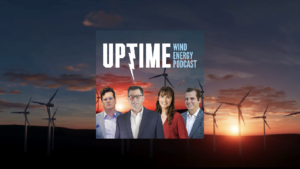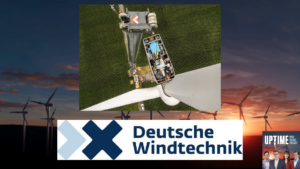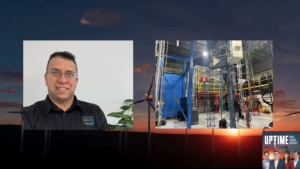Podcast: Play in new window | Download
Buildturbines.com is a resource for people joining the wind energy industry, from technicians to sales and marketing. The website includes career path information with experience and certifications needed as well as salary ranges. With in-depth articles and a training school location map, buildturbines.com is what you need to get started on your new career path.
Sign up now for Uptime Tech News, our weekly email update on all things wind technology. This episode is sponsored by Weather Guard Lightning Tech. Learn more about Weather Guard’s StrikeTape Wind Turbine LPS retrofit. Follow the show on Facebook, YouTube, Twitter, Linkedin and visit Weather Guard on the web. And subscribe to Rosemary Barnes’ YouTube channel here. Have a question we can answer on the show? Email us!
Pardalote Consulting – https://www.pardaloteconsulting.com
Weather Guard Lightning Tech – www.weatherguardwind.com
Intelstor – https://www.intelstor.com
Allen Hall: Welcome to this July 4th edition of the Uptime Wind Energy Podcast. I’m your host, Allen Hall, and I’m here with Joel Saxum, and we have some exciting news to share.
Joel Saxum: So the exciting news is that we put a new website together. It’s called buildturbines.com, and why we did it is to get more exposure to the wind industry.
We know we have a technician problem. Allen and I have talked to many people trade shows in person, our wind farm tours that we do, of course. Anybody you talk to in the wind industry, every single company is saying, Hey, everybody’s a recruiter. Everybody’s a recruiter. We need people. And then you even get down to the the training centers, the community colleges, they’re thinking, Hey, we need students.
We need students. And just the simple fact that we have a little bit of reach in the wind industry. We said, what can we do about this? So we put together some resources. On a website, it’s BuildTurbines. com again and we’re going to continue to keep adding to it to make it into a resource for anybody that’s interested in getting into the wind industry, whether it’s from a technician standpoint.
All the way to engineers and back office people, we want to put resources out there for them.
Allen Hall: Yeah, and the big push from an industry standpoint obviously is in employment, trying to get people into the positions or having a really difficult time. That is obvious and that even though some of the trade training schools and community colleges, which are doing a lot of the training in the United States, are having a hard time keeping those programs up and running because just the number of people applying for those positions to enter into a trade school is relatively low.
And I think it’s because a lot of young people don’t know that they can have a career and win. That is a long term career. You can make good money. You can raise a family on it. And you don’t have to have a college degree to go do it. And we’re just trying to raise some awareness about it and we’ve put out some information on the social media platforms LinkedIn, obviously.
We’re on the web at buildturbines. com and then we also have an Instagram page, which, the Instagram page looks great so far, Joel.
Joel Saxum: Yeah. Technicians are on Instagram, right? People are on Instagram these days. On the Instagram page, we’ll be sharing all kinds of resources. We’ll be sharing pictures. We plan to, right?
This is our goal with this. And we want to share pictures from the field, videos from the field, people doing their job every day. What’s actually happening out there. And then get people interested in, get young people interested, get mid career people interested in the wind industry, get vets coming out of their respective branches interested in the wind industry.
We sit in an odd space, right? The wind turbines are an oddly visible thing, right? They’re huge. You drive down the road, you see these things. So they’re visible to the person, but however, the industry isn’t that visible to the person, right? So you may see these turbines in your backyard or down the farm or in the next county over, but you look at them and you go I don’t know, how do I get in?
How can I do that? How can I get in? How can I work on these things? How can I get into that industry? Where we have competing industries is in not the same space, but like spaces, say the oil and gas world. When the oil and gas world needs people, they say, Hey, come to this. They’ll put out, ads on the, in the paper and ads on radio and stuff of this sort saying, come to this, we’re having a hiring fair, come to this hotel, bring your resume we’ll get people into jobs in the oil field that way.
We don’t do that as a wind industry because we do need a little bit of. Specific skills. If you’re, working on blades, you may have a work at heights thing. We might be working on ropes. There’s specific trainings that we need to go through all these things. Nothing’s really super basic.
But we need a resource for everybody to go to, right?
Allen Hall: So that’s what the, that’s what this thing’s going to do. Now, when you go to buildturbines. com, there is a jobs report. You can click on that link and you can download that jobs report. And what’s inside of there are the qualifications you need to be a win.
Turbine technician entry level or blade repair person or to be a site manager and which a lot of people don’t realize like those skills are achievable for a lot of people already in oil and gas or already in another industry or Just coming out of high school or coming out of community college those skillsets you probably possess As Joel pointed out, you may need a couple of training programs to get you introduced to the field, but nothing complicated.
We’re talking about usually a couple of weeks for a lot of these programs to get introduced, get the safety training you need, get yourself out in the field. If you have basic mechanical skills, basic electrical skills, you will be able to find employment relatively quickly in the wind industries, unlike some other industries at the minute.
And I think that’s the point, Joel, is that a lot of people are looking in places where there are not opportunities, and meanwhile Wind is, you should be knocking on the wind door right now.
Joel Saxum: Yeah, for sure. Every company that you talk to is looking for people, looking for good people. A lot of entry level technicians come out there just come, go out and do a hard day’s work, or a good day’s work, and you’re it.
On the website, we have a few different things, right? One of them being just some articles. If you’re new to the winnings field and don’t know that much about it, there’s just some information. What a day in the life looks like. How, what kind of technology you’re working with. What does it look like to work in cold weather?
Those kind of just general things or interesting things of little pieces of information that we’ve gathered over the years. And we’ll continue to add to that as well. We also have a section for training schools. So there’s a map and it has basically a nation, it’s a, there’s a nationwide search there for all kinds of training schools.
We also have on that same page some of the featured wind energy training schools. And these are friends of the podcast. These are people we know, people we’ve visited, we’ve been to their facilities. We encourage anybody that has a, a wind energy training school, get ahold of us get some input on this thing.
Share your marketing with us. How are we, how can we drive more people to you guys? That’s what we want to do here. We also have a section on the website about career paths, right? So we walk through the, wind turbine technicians, offshore wind technicians, site manager, project managers, engineers permitting specialists, safety, sales, all kinds of different things in this industry.
But we’ve gone to a little bit further of a level saying, okay, what does the job do? So what does a wind technician do? What kind of qualifications are required? What kind of on the job skills will you learn? Or is it nice to have? What are the salary expectations, right? How can you earn a living?
Like what, it’s a these are, this is the fastest growing industry by every job report that the federal government puts out and how can you earn a living in it? How can you make some money? The money’s there. The money’s good. Especially in some of these rural areas. So we have all of these different resources on the website.
It will continue to grow. It’s a living document, right? It’s like anything and we are happy to grab any kind of input from the market too.
Allen Hall: Yeah, and if you’re looking for a training school, and a lot of people new to the wind energy marketplace want to take some training, it’s probably the right thing to do for a lot of newcomers.
It can be hard to find training schools around you just searching the web. I don’t know why that is at the moment, but some of them are well hidden on the web. They’re there. They’re probably within an hour or two of where you currently are. But it’s sometimes hard to figure out where those resources exist.
So if you just go to build turbines. com and click on the link training schools, it’ll take you right there. There’s a map. You can find something real close to you and start talking to the advisors or the counselors at those schools and those training facilities to see what it would take to get started there.
And I think that’s one of the impediments, honestly, Joel, is that a lot of newcomers to the industry don’t realize that there is training close by.
Joel Saxum: Yeah, for sure. There’s 185 different programs in the states on this map in this resource from energy. gov. We know that there’s new ones popping up all the time, and some of the specific company ones may not be listed on here, right?
If it’s a Pierce Renewables or something like that is an internal company one, they would grab people and they put them through training, of course. They may not even be listed on this. So there’s even more than 185 on here. But when you look at the map training centers in probably 45 of the 50 States, to be honest with you.
Of course, a big concentration in the Midwest, right? So you see a lot of them in Illinois Iowa, Kansas, Texas up in even the Colorado, but there is also a heavy concentration of wind training schools over in the East coast. So we’ve got, of course, we’ve got some offshore wind happening over there, but the people may not know this very much, but there’s quite a few wind turbine farms.
In Pennsylvania and there’s up all the way into Maine and New York and West Virginia has some, so no matter where you are around the country, there’s wind and wind energy and wind resources near you and, Training schools to boot.
Allen Hall: And inside the jobs report, as Joel has mentioned, there are salary ranges, particularly for newcomers to the industry.
Those salaries are pretty high. Good. Sorry. I was, when we put this together, I was shocked at some of the entry level positions of what you could get. And that’s great. What the industry is looking for is qualified people, and they’re having a hard time doing it. So this is the right time to get interested and to look into being Wind at any level.
And that’s what buildturbines.com is all about. It’s just a resource for the industry to, to try to grow the number of people entering the industry that want to move up in the industry. And we do have a lot of resources there. And as, as Joel’s pointed out, it’s meant to be a resource for the industry.
Use it. Go to the Instagram page. There are some great videos up already there about. Learning how to be a wind turbine technician, how to get in, what some of the training schools look like. Those are easy. A couple of minutes of your time and you’ll, you can get educated pretty well on what the next steps are.
So it’s not particularly difficult to do and enter and to get started. But that’s the hard part, right? Getting started is the hard part. And Joel, particularly down in Texas, where the need for wind turbine technicians is so great, there’s a huge demand down there right now.
Joel Saxum: Yeah, it’s massive.
And Texas is, I think Texas says of 2020, Three produced almost 24 percent of the wind energy in the entire country, right? Like the amount of turbines down there is just astounding. It’s crazy. So we were talking Texas, but if you look at the whole country right now, we’re just shy of about 75, 000 turbines installed, 75, 000 turbines.
That’s a lot of work that needs to be done. And this is what’s installed, right? So in this job on build turbines. com, we have also things that aren’t directly related to being a wind turbine technician. There’s some language in there about how to get further down the road of being an environmental or a permitting person or someone in safety or someone in sales and marketing in the renewable industry.
We don’t need just technicians. We need the full gamut. Like this whole industry is booming. It’s growing. And we’re talking turbines here, right? Renewable energies is not just turbines, there’s battery storage and there’s solar and a lot of these skills can go from industry or I would say industry sector to sector, right?
I know we talked with a very big ISP just the other day and they said that’s one of the things they’re doing with training their people. They got wind people and they’re training them to work on solar stuff. So when they can’t get out on wind projects, they can go work on solar projects or battery storage projects or electric vehicle infrastructure or freaking timing, climbing telephone communications towers, like all of these things intertwine.
So they’re the. Opportunities are not just, hey, you can go work on a wind farm. There’s a lot of growth and a lot of career paths that can be chosen from here.
Allen Hall: And I think you do point out a good fact, Joel, that a lot of people that are in solar, that are in battery storage, came from wind. That they got trained up and went because it’s a good place to really learn a lot get your hands on actual equipment Learn how to operate it learn the intricacies Understand what’s happening on the power generation side.
Those are valuable skills that you can shop elsewhere So even if you wanted to change industries now, you’re loaded now your potential has gone way up in the meantime You’ve made a lot of money Pretty good living at being in the wind industry, and I think that’s key, and you have pointed out, too we’re not just focused on technicians, even though that’s where the demand, a lot of it, is right at the moment, but they need procurement people, they need front office people, they need back office people, they need people everywhere at wind.
And engineering is another one too, Joel, right? That there’s just not enough engineers in it. We see this all the time. There’s demand for engineers is at an all time high, I think, in Wnt. They can’t find enough people. And that’s what BuildTurbines. com is all about. It’s just trying to raise awareness and connect you up with the schools and hopefully eventually with your future employer.
Joel Saxum: Allen, I bet you in a month’s span, you and I probably have conversations with what represents 50 percent of the installed capacity in the United States. I would bet that’s the case and it is crazy how many times we run into people that are like, yeah, I’m in charge of whatever it may be rotating equipment for all of our turbines.
It’s Oh, so you have a degree in that. And you’ve trained in it. It’s Nope, I’m just an engineer that just needed an engineer. So so many good people out there, but people that are specifically trained for wind. It’s hard to freaking find them. So we encourage everybody to check out the website.
If you have any questions or input, get ahold of us. We’re happy to have a conversation, or if you have something where you point out on the website, Hey, this is not quite correct. Hey, we can adjust it, right? We own it. Let’s make this a resource for the whole industry and let’s do it as a team.










